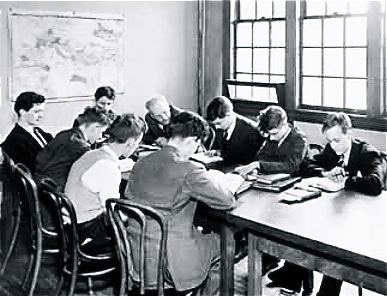Religious affiliation(s) Nonsectarian Head of School Anne Stavney Phone +1 952-988-3700 Founded 1900 | Established 1900 Faculty 122 Number of students 1,400 | |
 | ||
Type Private, College-prep, Day Motto Challenging the mind, engaging the heart. Address 511 Kenwood Pkwy, Minneapolis, MN 55403, USA Colors White, Brown, Royal blue, Kelly green Similar Breck School, Minnehaha Academy ‑ Upper Sc, Benilde‑St Margaret's School, St Paul Academy and Sum, Academy of Holy Angels Profiles | ||
The Blake School is a private, coeducational, nonsectarian PK-12 college preparatory day school, established in 1900. Blake is located on three campuses around the Twin Cities area of Minnesota: the upper school (9–12) being in Minneapolis; administration offices, middle school (6-8), and half of the lower school being in Hopkins, Minnesota; and the other half of the lower school being in Wayzata, Minnesota.
Contents
History
During the early 20th century, two schools were founded in Minneapolis to prepare students for elite colleges in the Northeast: the Blake School for boys and Northrop Collegiate School for girls. A third school, Highcroft Country Day School serving students of both sexes, was incorporated during the migration to Minneapolis suburbs. In 1974, the three schools merged to become the Blake Schools, with its first coeducational class graduating in 1975.
Blake
In 1907, William M. Blake established the Blake School, a private, preparatory school for boys, in Minneapolis. Three years later, Charles C. Bovey, a local businessman, wanted to reform Blake, and put it on the same plane as Eastern preparatory schools.
With help from William Blake, Bovey asked sixteen other local business leaders to contribute $2,500 each towards the school's first capital drive. In 1911, these original guarantors hired Charles B. Newton, a Princeton and Harvard alumnus, to replace William Blake as headmaster. Newton envisioned a school "not only for the wealthy, but for the worthy." The school incorporated on May 5, 1911, with all but two guarantors serving on the Board of Trustees. In 1912, their pooled resources enabled the construction of a new building in suburban Hopkins, with the site, now known as Blake Campus, being the current home of the middle school and one of the two lower school campuses.
Northrop
In 1900, Zulema A. Ruble, a Smith College alumna, and Carrie Bartlett established Graham Hall, a private school for girls, in Minneapolis. In 1914, a group of Minneapolis leaders purchased Graham Hall and incorporated it as Northrop Collegiate School. In 1917, the school relocated within Minneapolis, with the site, now known as Northrop Campus, being the current home of the upper school campus.
Highcroft
In 1958, Sage Cowles, wife of John Cowles, Jr., along with two friends, established Highcroft Country Day School, a private, coeducational, nonsectarian K-9 school in Wayzata. Highcroft was designed to provide an education near home, for students in the far western suburbs of the Twin Cities. In 1960, the school building was constructed on land purchased and donated to the school, part of which was the former Highcroft estate in Wayzata, with the site, now known as Highcroft Campus, being the current home of the other lower school campus.
Preservation and present
In addition to retaining the original sites of the three schools as part of the campuses of the Blake School, the school also carries on other traditions, such as:
The current head of school is Dr. Anne Stavney.
Academics
Blake promotes a well rounded, liberal arts education encouraging involvement in academics, athletics, and the arts. The school serves approximately 1,400 students in prekindergarten through twelfth grade, with an average classroom size of 15-16 students, and average graduating class size of 130. The school's student-adult ratio is 9:1.
It takes 22 credits to graduate from The Blake School, with a minimum course load of five courses each semester. The Blake School also offers global citizenship programs.
Accreditation
Blake is accredited by the Independent Schools Association of the Central States (ISACS), and is a member of the National Association of Independent Schools (NAIS), The College Board, National Association of College Admissions Counselors (NACAC), and the Cum Laude Society.
Recognition
Blake has received numerous accolades in recent years, including:
In 2011, Blake won the Minnesota Middle School Science Bowl, and was a competing school in the U.S. Department of Energy's National Science Bowl, winning the Hydrogen Fuel Cell Car Race portion. In 2015, it won the Department of Energy's Minnesota High School Science Bowl and proceeded to compete at the national level in Washington D.C.
Athletics
Blake competes in the Independent Metro Athletic Conference (IMAC) and formerly in the Tri-Metro Conference, which is part of the Minnesota State High School League. The school athletic teams are named the Blake Bears, with the school colors being royal blue, kelly green, brown, and white. The school offers twenty-eight sports, and fields over fifty athletic teams. The school also recognizes four club sports, including Ultimate Frisbee, Equestrian Team, Sailing, and the Stepps Dance Team. They are also recognized for having their hockey team in a cameo for the 1996 Disney movie D3: The Mighty Ducks when the movie was shot on set at Blake's Hopkins campus hockey arena; they came from behind down 9-0 to tie the Ducks 9-9, with 9 third period goals.
History
Blake won the Minnesota State High School League Challenge Cup, which awards schools based on their success in section and state fine arts and athletics tournaments, in 2005, 2007, 2009, 2012, 2013, 2014 and 2015 - more than any other school in state history - and was runner-up in 2006, 2008 and 2010, and placed third in 2011.
